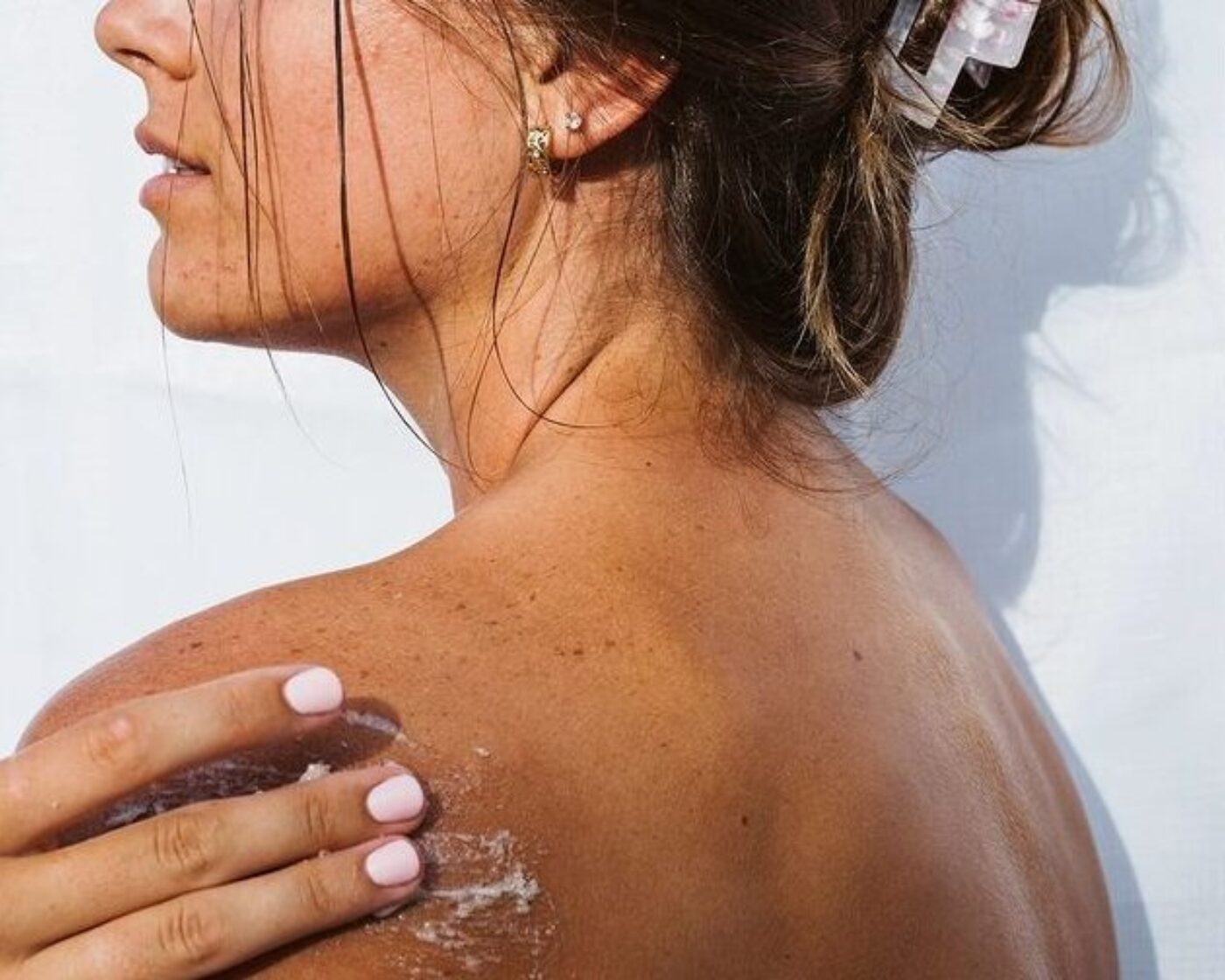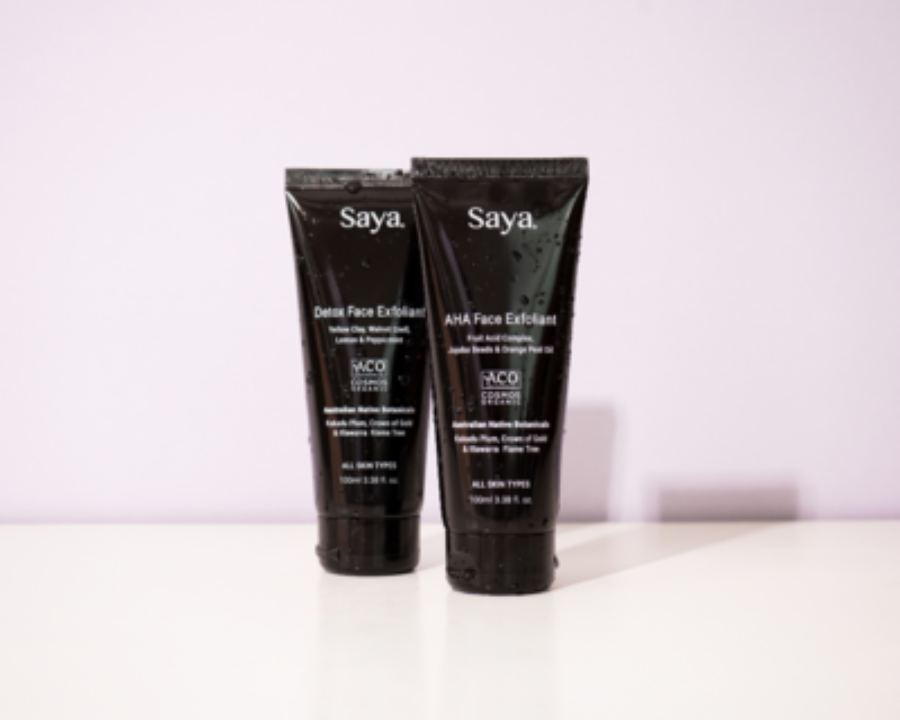
Written by Saya Skincare
Exfoliation is the key to healthy-looking, soft skin and there are two ways to go about it: chemical or physical. Both chemical and physical exfoliants get rid of dead skin cells which speeds up cell turnover, leaving skin brighter and clearer. So what’s the difference between the two? Which method you choose depends on a number of factors: your skin type, preferred usage, and what you’re trying to target. Read on for a full breakdown of which type of exfoliation is best for you!
Why you should exfoliate.
Simply put, exfoliating is the process of removing dead skin cells from the surface of your skin. This uncovers fresh new cells, allowing moisturising products like serums to penetrate more deeply into the skin and retain it! Not only does exfoliation keep the skin looking fresh and healthy, but it also helps to prevent dryness, flakiness, and clogged pores.
Fun Fact: Your skin naturally renews itself every 25 to 30 days, however, this period gradually slows down with age.
Exfoliation is vital for oily skin.
If you have an oily complexion, exfoliation is an absolute must. Increased oiliness makes it harder for dead skin cells to shed off naturally which end up blocking pores. This is why oily skin can be prone to breakouts. Exfoliating helps reduce and prevent acne by removing bacteria from the surface of your skin.
Improves the complexion
Wondering how to get that glowy complexion? Exfoliation makes a huge difference to the health and appearance of your complexion by:
- Preventing and softening fine lines and wrinkles.
- Helps to keep pores clean and prevent clogging (This means fewer blackheads)
- Smoothes & improves skin tone by getting rid of dulling skin cells.
Encourages cell turnover
Exfoliation helps your skin renew faster! Age, sun damage, and hormonal changes can slow down the body’s natural shedding process. By exfoliating away dead, dull cells, you’re revealing new fresh skin which increases cellular turnover.
Physical & Chemical: What the difference?
Okay so now that we have an understanding of just how important exfoliation is, let’s dive into the different types and why one may be more beneficial than the other.
Physical Exfoliation
Physical (also known as manual) exfoliation contains rough ingredients such as coffee, sugar granules, walnut shell, or jojoba beads. These granules help to shed away impurities, dirt, and oil residue along with buffing away dead skin. For some, the gritty texture of physical exfoliants is what it’s all about. Depending on your skin type, physical exfoliants work extremely well, especially when formulated with the right-sized grains. Physical exfoliants are best suited for normal to combination skin types.
In need of a physical exfoliant? Our Detox Face Exfoliant is made with French Yellow Clay, Papaya, and finely ground Walnut Shells. The papaya enzyme acts similar to an AHA (you’ll find out more further on) eats away at dead skin cells. Yellow Clay acts as a tonic on the skin and helps to draw out toxins from the skin.
I have sensitive skin, can I use a physical exfoliant?
We know how tricky it can be when choosing new skincare products especially when you have sensitive skin. For those with sensitive skin, chemical and physical exfoliants can be used however it's best to proceed with caution. When choosing a physical exfoliator look for gentle ingredients with super fine particles ( like jojoba beads) to avoid irritation.
Chemical Exfoliation
While physical exfoliants remove the outer layers of skin manually, acids do this chemically. However don’t be alarmed by the name, these are skin-friendly chemicals.
We are going to get a little scientific here but trust us, it’s worth knowing the difference. There are five different types of chemicals that can be great alternatives for those with sensitive skin, rosacea or eczema. Each targeting different skin concerns & benefits.
- Alpha Hydraulic Acid ( AHA)
- Beta Hydroxy Acid (BHA)
- Lipo Hydroxy Acids (LHA)
- Polyhydroxy Acid (PHA)
• AHA’s
These are water-soluble acids obtained from natural substances like sugar cane, milk, and citric fruits. AHA’s include glycolic acid (we love!), lactic acid (also one of our favourites!), tartaric acid, citric acid, malic acid, and mandelic acid. They help to dissolve the ‘intercellular glue’ that holds our skin cells together which in turn helps to enhance our skin cell shedding process. Glycolic acid is one of the most well known in the AHA family. Because glycolic acid is the smallest member, it can penetrate the skin more easily and works faster. Glycolic Acid also has a collagen-boosting superpower which keeps to firm skin and fights signs of ageing. Lactic acid, on the other hand, is a much more gentle exfoliation option. It increases the skin’s moisture level and is an amazing humectant ( ability to retain moisture) - perfect for sensitive skin!
• BHA’s
BHA’s are a group of acids that are oil-soluble which include salicylic acid and some forms of citric acid. These are great for getting through oil-clogged pores and decreasing oil production. If you have oily skin, this is your go-to! BHA’s help to clear out pores which in turn reduces the appearance of enlarged pores. Salicylic acid is particularly great for treating acne and blackheads.
• LHA’s
Difference between BHA’s and LHA’s? LHA’s are derived from salicylic acid and have a similar purpose. LHA’s are more gentle on the skin because they penetrate the skin at a slower pace.
• PHA’s
Lastly, PHA’s fall under the AHA family and are the most gentle chemical exfoliant of all. PHA’s are also the newest acid in the skincare world. Because they have a bigger molecule weight, these acids penetrate the skin at a slower rate and are non-irritating to the skin.
Looking for a gentle chemical exfoliant? Our AHA Face Exfoliant combines a complex blend of AHA’s from botanical sources (Bilberry, Sugar Cane, Sugar Maple, Orange, and Lemon) which dissolves, breaks down, and removes surface dead skin. Formulated with finely milled Jojoba Beads that gently buff away the dead skin cells. This is perfect for all skin types including sensitive and delicate skin.
What About Enzyme Exfoliation?
Enzyme exfoliation is changing the skincare game. However, we don’t want to overload you with information so we’ll keep it brief! Enzymes are bio-active ingredients often derived from fruits like papaya. Because enzymes digest only the dead skin cells attached to the upper layer of skin, they don’t damage the healthy skin underneath as other exfoliants may. If you’re finding that BHA’s or AHA’s are too much, an enzyme exfoliant might be the perfect solution for you. Looking for an enzyme exfoliant? Try our Detox Face Exfoliant. Leave on the skin to allow the papaya enzyme to work its magic!
Which One Should I Use?
It all comes down to personal preference and skin type. Some prefer the textural experience of a physical exfoliation whereas others feel like they get better results from chemical exfoliation. Others, on the other hand, love both! Remember exfoliating isn't just for the face. Looking for a natural glow from top to toe? Our Coffee Body Scrub will melt onto your skin - exfoliating and moisturising all in one.
Have an exfoliation preference? Leave a comment below and let us know!
Don’t overdo it!
Even in skincare, too much or too little of something can lead to problems. So always make sure to build up your tolerance to exfoliation. Think you may have overdone it? Read ‘Over-Exfoliated? Don’t Overthink it!”.



